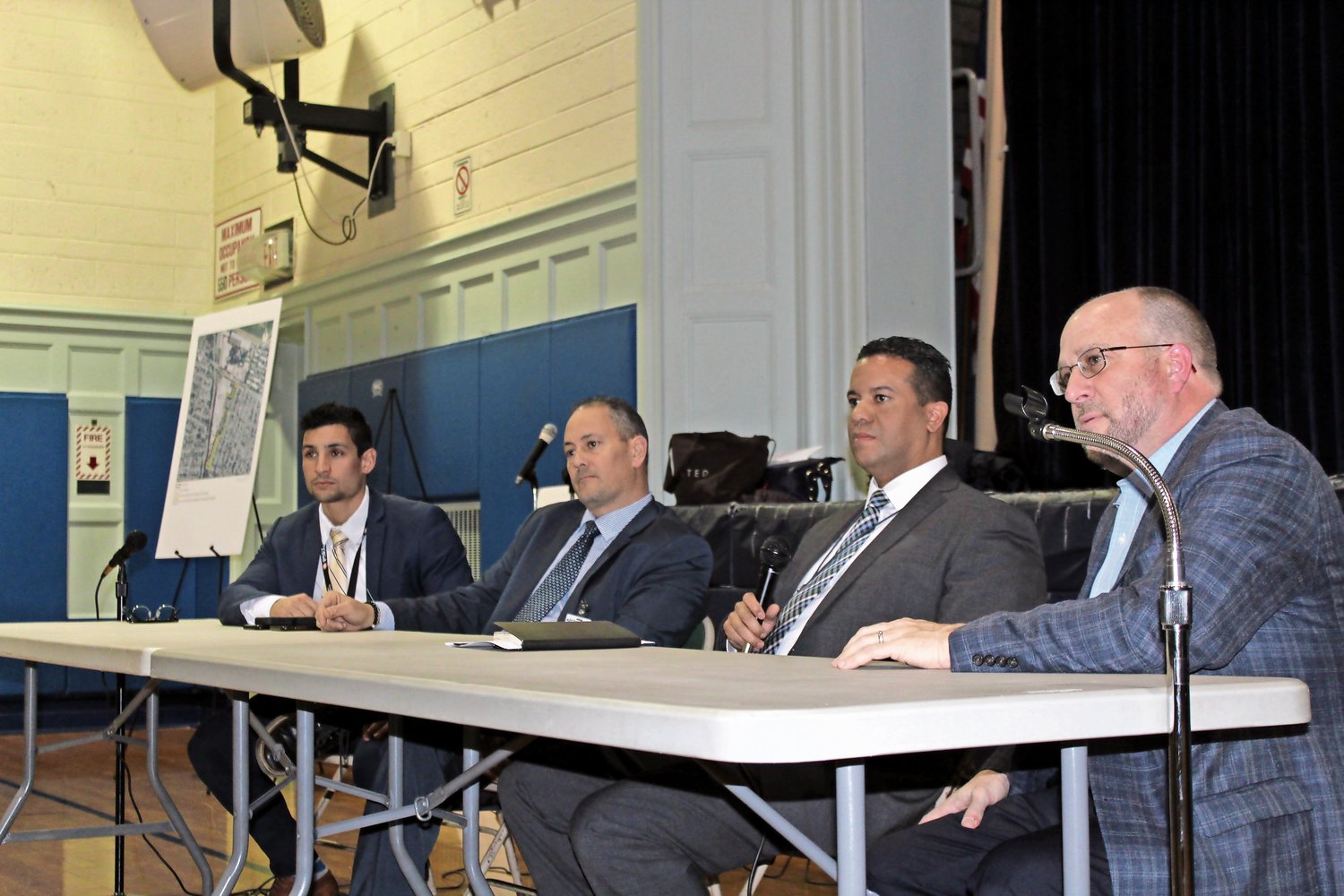Belmont project coming together
The various components of the Belmont Park redevelopment project are coming together, officials said at a community update on Feb. 27.
Almost all of the foundation for a new 19,000-seat New York Islanders arena is in place at Belmont Park, said Anthony Lopez, senior project manager for Manhattan-based Sterling Project Development. Construction crews have dug out the site, he noted, and steel is being installed in quadrants, with quadrants A and B in place. Workers will soon pour concrete on the steel, Lopez said, and he expects the majority of the steel and the roof to be installed by this summer.
“By the summertime of this year,” he said, “you’re going to see a fully developed building.”
A new substation to power the arena and retail center is also about 60 to 70 percent complete, according to Peter Montalvo, associate project manager of PSEG. The station will include underground circuits, and will help the utility provide electricity to surrounding neighborhoods.
Meanwhile, construction of a new full-time Elmont Long Island Rail Road station, on the west side of the park, is expected to begin in the spring. LIRR officials have worked on the station’s design since last fall, Hector Garcia, the railroad’s sen-ior director of external affairs, noted, and the Metropolitan Transportation Authority board approved a $65 million contract for its construction at the end of January.
The station will be on the Hempstead line, with 150 parking spaces set aside for Elmont residents. The south platform, serving eastbound trains, is to be completed by October 2021, Garcia said, with the north platform finished a year later.
New York Arena Partners is also working to improve two Elmont parks as part of its agreement with the Town of Hempstead. The company is redeveloping Elmont Road Park, which floods regularly and has fallen into disrepair over the years, and is doing a “face-lift” on Hendrickson Avenue Park, according to Glen Kozak, senior vice president of operations for New York Racing Association, which owns the land at Belmont Park.
“The commitment is to have those projects completed before this arena opens,” Kozak said. “So that’s the commitment we made, and we’re sticking to it.”
As work continues, anyone living near Hathaway Avenue and Wellington Road can apply to New York Arena Partners to have their single-paned windows replaced with double-paned ones and to have in-window air-conditioning units installed to mitigate noise.
Residents said, however, that they still have questions about parts of the redevelopment project. Matthew Sexton, from Floral Park, questioned whether the state would do another environmental impact statement on the Long Island Rail Road station. It was originally included as a traffic mitigation measure in Empire State Development’s final environmental impact statement, which promotes development across New York.
The Elmont station will abut a Floral Park elementary school, and residents have expressed concern about possible Agent Orange at the site. Agent Orange was used as an herbicide in the 1970s, and is linked to cancer, diabetes and birth defects.
“Will you, as a courtesy to the residents, do a proper environmental assessment of that station?” he asked, noting that Agent Orange was found at 50 percent of the sites studied in Floral Park.
In response, Garcia said, an environmental review was included in the final environmental impact statement. It says that prior to any development, New York Arena Partners and the LIRR must sample soil and groundwater at the site, and they must not adversely affect air quality.
Lakecia Gayle, who lives near the retail village site, raised concerns about traffic. She recounted how one girl pulled down her pants and urinated into her cars after last year’s Belmont Stakes, when people park their cars on her street to avoid paying for parking, and Gayle has previously had beer bottles thrown onto her property.
“We have to plan to either leave for the day or just stay home all day, but there’s no getting out of my house and then coming back during the day of the Belmont Stakes because it’s a nightmare,” she said. “And it seems like they don’t respect our community. It might not be the best, but it’s what we have, and we take good care of it.”
She said she was worried people would again park on her street for Islanders games and concerts at the arena, and perform more drunken acts. To remedy that, Kozak said, the New York Racing Association and the Islanders plan to work with Nassau County police to enforce traffic regulations.
Additionally, Aubrey Phillips, vice president of the Parkhurst Civic Association, raised several concerns. First, he asked about a proposal to add two 30,000-gallon propane tanks to heat the arena. The developers originally proposed using natural gas, but when National Grid put a moratorium on new gas hookups last year, officials included the tanks as an alternative in the final environmental impact statement.
The moratorium has ended, though, Lopez said, he does not think the propane tanks are necessary.
But when Phillips also asked how a payment-in-lieu-of-taxes agreement could affect Elmont residents’ taxes, none of the panelists knew the answer. According to ESD officials, the PILOT agreements for the arena, hotel, and retail village will generate $272 million over 49 years — with $154 million for the Elmont and Sewanhaka school districts, $103 million for Nassau County, and $15 million for the Elmont Fire District. The PILOT for the hotel is to be phased out in 20 years, and the retail area, in 15 years, after which property taxes will be fully paid.
“Though we appreciate them having this community meeting,” Phillips said, “on the pressing issues the community has, they had no answers.”
Ronny Reyes contributed to this story.

 39.0°,
Fair
39.0°,
Fair 







